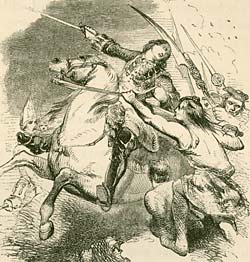The retreat of the Highlanders and the battle of Falkirk
The retreat began on Friday 6th December, 1745 -'Black Friday' to the Highlanders. It was very different from the march south. Then Charles had marched with his troops, a targe (shield) on his back, and had refused to ride in a carriage (Document 12). This cheered and encouraged the Highlanders, who marched well to the sound of the bagpipes and did not steal or burn things in the countryside through which they were passing. Now the Highland army was retreating, the English civilians grew braver and attacked them as they passed. The dispirited Highlanders got their revenge by stealing and destroying whatever they could.
Behind the rebels came the army of the Duke of Cumberland. Wade again attempted to cross from Newcastle to cut Charles off - but again he failed. Charles returned to Scotland late in December and there he heard that 4,000 Jacobites (including troops from France and Ireland) were waiting in Perth to join him. It may have been this news that made Charles decide to besiege Stirling castle, which was defended by British troops.

Highlanders with swords attacking a British soldier on horseback, 1745
From Anonymous, Soldiers and Sailors; or, anecdotes, details and recollections of naval and military life (London: John Harris, 1842)
It was now January 1746, and Marshal Wade was no longer in command. His place had been taken by Lieutenant-General Hawley, who was made commander-in-chief of the government forces in Scotland. Hawley was more energetic than Wade: he first occupied Edinburgh, and then marched to relieve Stirling. On 17th January, 1746, his troops met the Highlanders at Falkirk.
On this occasion, Lord George Murray was responsible for deploying the Highland army. He chose a good position, the 'hill of Falkirk', about a mile from Hawley's army. The Highlanders were drawn up in two lines to await the attack.
The battle opened with a cavalry charge, but since the government troops had to charge uphill in the face of driving rain and hail they were thrown back, and became tangled up with the advancing British infantry. At this point the Highlanders charged, and forced most of the British army to flee. The British right wing held, and managed to cover the retreat. Even so, a large number of British soldiers were killed, and the battle was a definite victory for the rebels, who plundered the British baggage train.
Document 13 is written by a government supporter. In one section he describes the battle, and tries to give the impression that the British did not lose. Later in the letter he shows the rebels' claims about the battle.
Afterwards Prince Charles again laid siege to Stirling castle. By now, many Highlanders had deserted, taking with them the plunder from Hawley's army. The chiefs pressed for a return home, saying that a new army could be raised in the spring to fight Cumberland. Charles protested, but the siege of Stirling castle had to be abandoned and the retreat began again in February.
The Highlanders split into two divisions and agreed to meet in Inverness. Cumberland followed the main Highland army as closely as he dared, giving the Jacobites no time to recover. He chased them to Perth, then to Aberdeen, where he halted to receive supplies from British ships. Here he improved the discipline of his army, and made sure it had arms, ammunition and equipment (Document 14). He also spent time training his troops to fight against the Highlanders. The soldiers were taught how to form up three lines deep. The first line knelt; the second stooped; and the third stood upright. This meant that they were all able to fire at the same time, when the enemy were close. If the enemy managed to reach the British line, the soldiers were told to use their bayonets to stab the Highlander to their right (not the man in front). This was because the man could thus be pierced under the armpit when he lifted his sword arm.
The British army then continued its march towards Inverness.
Next page: The Battle of Culloden